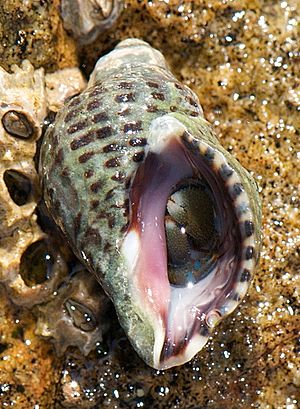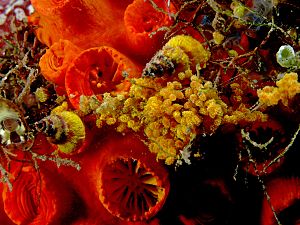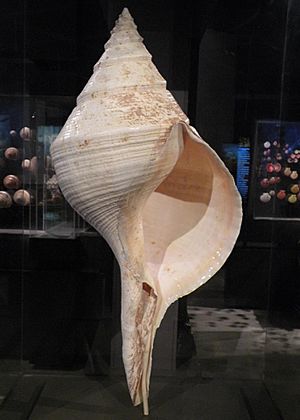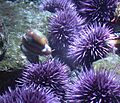Sea snail facts for kids
A sea snail is a common name for a type of slow-moving sea animal that usually has a shell you can see. They are part of a group of animals called molluscs, which also includes clams and octopuses. Sea snails are also a kind of gastropod, just like land snails and slugs. The main difference between a snail and a slug is that snails have a shell, and slugs usually don't. Some well-known sea snails are whelks and abalone.
Contents
What is a Sea Snail?
It can sometimes be tricky to decide if a gastropod should be called a sea snail. Some species live in brackish water, which is a mix of fresh and salt water. These might be called either freshwater or marine snails. Also, some snails live right where the ocean meets the land, near the high tide line. They might be considered sea snails or even land snails, depending on where they spend most of their time.
How Sea Snails Are Built
Sea snails are a very large and varied group of animals. Most sea snails breathe using special organs called gills, similar to how fish breathe underwater. However, a few types of sea snails have a lung and can breathe air! These air-breathing snails live in areas where the tide goes in and out, and they are active when the water is low. Examples include false limpets.
Many, but not all, sea snails also have a special "door" called an operculum. This hard plate can close the opening of their shell, protecting them from predators or from drying out when the tide is low.
Sea Snail Shells
The shells of most sea snails are shaped like a spiral, like a winding staircase. But some have shells that are shaped like a cone, and these are often called limpets. There's even a very unusual family of snails called Juliidae where the shell looks like two hinged plates, almost like a clam! People sometimes call them "bivalved gastropods."
Sea snail shells come in many shapes and sizes. They can be tiny, less than 1 millimeter, or very large. The biggest living shelled gastropod is the Syrinx aruanus, whose shell can grow up to 91 centimeters (about 3 feet) long! Because their shells are often strong, we can find many fossilized sea snail shells, which helps us learn about them from the past.

The shells of snails grow at different speeds. How fast they grow depends on things like the water temperature, how deep the water is, and how much food the snail can find. Scientists can even study the layers of a snail's shell to learn about its growth and the conditions it lived in.
How Sea Snails Are Used
By Humans
Many types of sea snails are eaten by people all over the world. Some popular ones include abalone, conch, limpets, whelks, and periwinkles. These snails are often gathered from the wild or raised on farms.
The beautiful shells of sea snails are often found on beaches. Because they are pretty and strong, people have used them to make jewelry, like necklaces, for thousands of years.
Some large sea snail shells have a thick, shiny inner layer called nacre, also known as mother of pearl. This material was once very important for making buttons.
By Other Animals
Sea snail shells are very important for many kinds of hermit crabs. Hermit crabs don't grow their own shells, so they find empty sea snail shells to live in for protection. A hermit crab holds onto the inside of the shell with special parts on its tail. As the hermit crab grows, it has to find a bigger shell to move into!
Images for kids
See also
 In Spanish: Caracola para niños
In Spanish: Caracola para niños
- Freshwater snail
- Terrestrial molluscs
- Land snail
- Sea slug
- Slug







